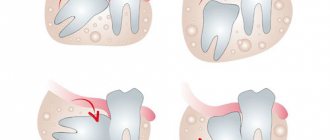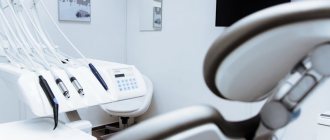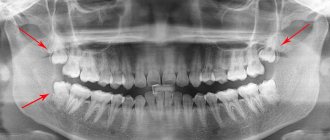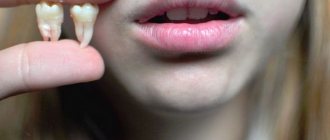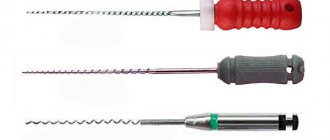Patients who call an orthodontic center to make an appointment are first of all interested in the cost of teeth straightening. The answer to this question can serve as an indicator of the quality of treatment in the center, since a specific amount can only be named after examining the patient, diagnosing the condition of his teeth and drawing up a treatment plan.
Installing braces is usually only part of a voluminous and lengthy job, and the final amount may include not only the cost of braces , but also the cost of caries treatment, tartar cleaning, and sometimes even tooth extraction.
Of course, the treatment plan proposed by the orthodontist must be explained to the patient and agreed with him. And at this stage, problems most often arise due to the need to remove several teeth, voiced by the doctor.
Braces and wisdom teeth removal
On the Internet you can find a lot of information that before orthodontic treatment it is imperative to eliminate the eighth teeth. However, this statement is not entirely correct: “eights” are not always disposed of, but only in cases of extreme necessity. As a preventative measure, removing third molars is incorrect and even dangerous. Correctly erupted “eights” are the same part of the dentofacial apparatus as other teeth, provided, of course, that they have antagonists. Moreover, extracting the “eight” is not such an easy process.
Interesting fact!
In cases where there is clearly not enough space in the bone for the correct placement of teeth, specialists can remove the “eights” without waiting for them to erupt.
Nevertheless, when a patient is indicated for removal, experts pay attention to the wisdom teeth first - and here's why.
- They erupt later than others, between 16 and 27 years, which often negates the results of treatment carried out in adolescence.
- The process of their eruption is often associated with various complications (in about 75% of cases) - and this also affects the location of other teeth.
- “Wise” teeth sometimes remain impacted and do not participate in the bite, which makes them an unnecessary vestigial organ and a prime candidate for removal. However, there are situations when the patient simply does not have third molars or their extraction is not enough to correct the anomaly - in this case, it is necessary to resort to the removal of other teeth.
Consultation with orthodontist O.A. Baranova
The problem of lack of space for normal teeth growth is quite common. Modern food is processed, soft, and the jaws lack the load necessary for growth and development during the deciduous and mixed dentition period. Underdevelopment of the jaws leads to a lack of space for permanent teeth, which are much larger in size than baby teeth.
Orthodontist O.A. Baranova conducted an examination and talked about the possibilities of orthodontic treatment. There are two treatment options for crowded teeth – with or without tooth extraction. In Olga Baranova's ORTHODONT PROJECT, tooth extraction is rarely used, but in this case, with severe crowding of teeth and a thin biotype of periodontal tissue, the girl still has full-fledged “eights”, so all the signs are for treatment with extraction. In this case, treatment with tooth extraction will lead to the most competent, aesthetic and stable result.
Contrary to a rather strong misconception that everything can always be treated with the Damon brace system without removal, this work shows that NOT AT ALL. And Dr. Dwight Damon himself never proclaimed such a thing. Everything must be done according to indications. In this work O.A. Baranova suggested using Damon braces with tooth extraction. Damon self-ligating braces glide easily along the archwire, applying constant, low forces to your teeth and moving your teeth into new positions faster than other braces. In this situation, a passive self-ligation mechanism was used to quickly close the gaps from the extracted teeth.
For accurate calculations and choice of treatment method, the patient must undergo in-depth diagnostics, which includes photometry, calculation of OPTG and TRG images in the lateral projection, calculation of jaw models, consultations with an osteopath and psychologist.
Photometry before orthodontic treatment:
Orthopantomogram (panoramic image) before treatment:
Treatment plan approval
Based on the results of research and consultations, orthodontist O.A. Baranova drew up a treatment plan, which she introduced to the patient at the second consultation. Calculations of the images showed that the option of removing teeth will prevent problems with the gums and bone tissue of the jaws, fraught with the tooth root extending beyond the cortical plate, and will allow the teeth to be straightened fairly quickly.
Orthodontist diagnosis:
crowding of the frontal group of teeth of the upper and lower jaw, narrowing and shortening of the upper and lower dentition. Occlusion is normal.
The tooth extraction was carried out by a dental surgeon at the clinic, since all the necessary specialists work together with orthodontists.
Removing "fours" or "sixes"
Sometimes, before installing braces, the patient needs to have the “fours” removed, that is, the first premolars - they have the smallest roots, so they are the easiest to pull out.
In addition, they bear less chewing load than, for example, molars, so their loss will not affect the patient’s health. The third candidate for removal is the fifth teeth. They are slightly larger than the “fours”, but the gaps left after their removal are practically unnoticeable when talking and smiling. Frontal teeth and canines undergo extraction much less frequently. “Sixes” are removed as a last resort, since they are quite difficult to remove, and the holes left behind them take a long time to heal. As for the seventh tooth, it is pulled out only if there is a healthy eighth tooth, in order to shift part of the load onto it. In addition, which teeth need to be extracted depends on the type of bite.
✔
In case of crossbites and distal bites, premolars, that is, either the fourth or fifth teeth, are most often removed.
✔
In case of an open bite associated with severe crowding and/or protrusion - protrusion of one of the jaws, removal of the upper and lower premolars, and at a very young age, also the canines, is indicated.
✔
As for the mesial bite, to correct it, the lower incisors are eliminated - in case of underdevelopment of the upper jaw - or “eights”.
Important!
A competent specialist, regardless of the indications, will always prefer to remove a diseased or decayed tooth rather than a healthy one.
Start of orthodontic treatment
Before starting orthodontic treatment, two teeth were removed on the upper and lower jaws on both sides (surgeon I.I. Yakimenko). According to the orthodontist's calculations, teeth 1.5, 2.5, 3.5, 4.4 were removed.
Sanitation of the oral cavity was carried out.
Before you attach braces to your teeth, you will receive a professional teeth cleaning to thoroughly remove plaque and learn how to brush your teeth with braces.
Damon metal braces on teeth:
Tooth extraction before installing braces and treatment time
In most cases, contrary to popular belief, extraction does not increase the treatment time, but, on the contrary, shortens it. For example, if the patient has severe crowding, then extraction will speed up the process of moving teeth by at least a couple of months, if not more. However, if the situation allows you to do without removal, then the fate of the tooth depends on the patient’s decision. In addition, you should not be afraid that after extraction there will be gaps between the teeth - they will close during orthodontic treatment. Usually it takes from three months to six months to eliminate them, depending on which tooth was removed. The gaps close at a rate of approximately 1 mm per month, so the smaller the tooth removed, the faster they will heal. As mentioned earlier, the smallest holes remain after removing the “fours”. Extraction is usually performed a week before braces are installed.
Important!
Removing an inflamed tooth during orthodontic treatment can negatively affect the timing of correction, therefore, before installing braces, the oral cavity must be completely sanitized.
Cost of removal when installing braces
The price of the procedure consists of several indicators: the complexity of the surgical procedures, the duration of the operation, the number of elements removed, the type of anesthesia, and the cost of drugs. For example, extracting an incisor will cost less than a premolar and at least half as much as a figure eight. General anesthesia also increases the price of the service.
In our dental clinic, you can remove several teeth at once under sedation or anesthesia. This is an absolutely safe and painless treatment. We always strive to preserve the integrity of the dentition. We have dentists of various specializations who, in difficult cases, will hold a consultation to make the right decision. The cost of treatment and removal is discussed with the patient before the procedures begin.
Is it possible to avoid tooth extraction?
In order not to be faced with the choice of which tooth to remove and whether it is worth doing it, it is necessary to monitor the formation of the child’s bite from an early age. Many parents believe that they need to make an appointment with an orthodontist only when baby teeth are replaced by permanent teeth. This is an erroneous opinion: it is recommended to show the child to a specialist for the first time at the age of 2-3 years, so that the doctor can identify the prerequisites for the development of dental anomalies in time.
What do parents of young children need to pay attention to?
- On the child’s bad habits (constantly sucking his thumb, chewing on various objects, and will not part with his pacifier). Even improper bottle feeding can lead to underdeveloped jaws.
- Due to adenoids or frequent acute respiratory viral infections, the child adapts to improper (oral) breathing, and this negatively affects the condition of the entire dental system.
- Children sleep incorrectly (throw their heads back too far, put their fists under their cheeks, etc.). They don't watch their posture. All this prevents the correct formation of the dentition and the temporomandibular joint.
If these problems are addressed in a timely manner, then in the future there may be no need to remove healthy teeth that interfere with orthodontic correction. The orthodontist will prescribe myogymnastics and select vestibular plates and trainers. Treatment in adulthood, if carried out, will be more comfortable and take less time.
Treatment with Damon braces
The patient visited the orthodontist every 1.5 – 2.5 months.
2.5 months after installing braces on the teeth, the gaps between the extracted teeth have noticeably decreased:
At the appointment, the orthodontist changed the arches according to the treatment plan, monitored the progress of treatment, and gave recommendations on dental care. Good hygiene is very important, since the health of the teeth, as well as the condition of the enamel after removing braces, depends on the thoroughness of removing plaque around braces and under the arches. If plaque is not removed well, the tooth enamel loses minerals and after braces are removed, white spots (foci of demineralization) become especially noticeable. Orthodontists advise anyone who is not confident that they can maintain good hygiene to get lingual braces, which do not leave marks on the outer surface of the teeth.
4 months after the start of treatment, the shape of the dentition became much smoother; there are still gaps from the extracted teeth:
8 months after starting treatment with Damon braces:
To create proper contacts between the teeth, the orthodontist prescribed wearing elastic bands. Orthoelastics are worn all day and overnight, only being removed for hygiene purposes. To completely close the gaps from extracted teeth, the bracket system is supplemented with special closing springs.
View of teeth after 1 year and 4 months from the start of treatment:
Does it make sense to wear braces without removing teeth?
As we have found out, removal is required in cases where there is not enough space in the jaw for the correct arrangement of teeth. Unfortunately, without extraction in such situations, orthodontic treatment will be ineffective. The teeth, taking the desired position, will either be forced to shift their inclination, or simply will not budge. Only timely orthodontic treatment in childhood will help to avoid removal.
Publisher: Expert magazine about dentistry Startsmile.ru
Author of the material: Yaroslav Ikonnikov
Causes of distal bite
This form of bite is formed by several factors:
- Genetic predisposition
- Untreated ENT pathologies
- Difficult nasal breathing
- Bad childhood habits
- Postural disorders
- Birth injuries
- Sucking pacifiers after one year
- Food too soft
- Mineral deficiency in the body
- Mechanical injuries
These reasons contribute to the formation of a heavy, underdeveloped lower jaw and accelerated growth of the upper jaw. This is called a distal bite.
Treatment in adults
Correcting a distal bite in adults takes longer than in children, since the jaw bones have already become stronger and formed. How to correct distal bite in adults? Treatment is selected by the orthodontist based on individual indications. The most effective and safest method is a brace system made of metal or ceramics. According to indications, the doctor may remove several teeth from the upper jaw to reduce the length of the row. After treatment, the bite is leveled.
Treatment of distal occlusion in adults with braces is complemented by gymnastics to strengthen the facial muscles. Most often, the treatment of deep distal bite in adults is surgical.
Treatment of distal occlusion in adults without surgery is possible with an integrated approach, but in severe cases only surgery can help. The price for correcting distal bite in adults is from one hundred and twenty thousand rubles and above. It all depends on the severity of the distal occlusion.
Is it possible to get braces without removing teeth?
Most patients look at photos of teeth in braces before installing corrective systems.
Some illustrations show that preliminary removal of individual elements was carried out, while in others the row remains intact. Patients ask themselves whether it is possible to install braces without prior extraction. Dentists cannot answer this unequivocally. Much depends on the size of the jaw and how the elements are arranged in it.
It is possible to install braces without first removing premolars and molars if they are in good condition and the jaw size allows you to change the position of the crooked units.
Is it possible to install a fixed structure without removing healthy teeth?
Lost teeth can no longer be restored, and this fact excites the imagination of many patients who are offered to remove molars before installing braces.
The presence of eights in the dentition, as recent dental studies show, is not necessary at all. These organs are called by many experts an evolutionary error. They are not at all useful. Therefore, removing figure eights for braces should not alarm the patient. Having lost them, they will not lose any functional qualities of the jaw, but, on the contrary, will acquire a beautiful smile and ideal dentition.
If you need to pull out fours, the situation is a little different. After all, these are the organs of the jaw that are actively involved in the process of chewing food. They are removed only in a situation with subsequent relocation and replacement of the void.
In a situation with canines that protrude too much from the general row or, on the contrary, fall into it, the fours must be removed. After all, removing the fangs themselves will be visible and will not make the smile beautiful, and fours are teeth with small roots, which are easiest to remove. This will free up space and the fangs will be able to fit straight into the dentition.
How to prepare your teeth for braces
- First of all, an external examination of the dentition, face and oral cavity is performed.
- In addition to the teeth, the condition of soft tissues is examined and assessed.
- Diagnosis is made using orthopantomography and visual examination.
- X-ray photographs of the jaws are studied.
After which the doctor decides what treatment measures should precede the installation of braces. Based on the state of the dentition, teeth for installing braces are divided into three groups:
- Group A, in which high-quality dental treatment and plastic surgery to reduce the frenulum are performed;
- Group B – carry out measures to preserve teeth;
- Group C – minimal manipulations are performed that do not create risky complications.
In what cases are fours removed to install braces?
Orthodontics is a branch of dentistry that deals with the treatment and prevention of jaw abnormalities. At the very beginning of using braces, dentists neglected removal. Extraction of individual elements was carried out in almost all of them. Over time, the view of specialists on this issue has changed.
Modern orthodontists strive to carry out organ-preserving bite correction. Four teeth in a row are removed only in extreme cases, when it is impossible to do without this procedure.
On a note!
If the dentist insists on extraction, it is recommended to consult another specialist. Sometimes a more experienced orthodontist can correct the bite while preserving healthy premolars.
It is necessary to remove quads for adolescents and adult patients whose teeth are crowded due to the anatomical features of the jaw. With a narrow bone and large molars, the canines and incisors shift. As a result, individual elements are bent, layered on top of each other and out of alignment. If it is impossible to return the protruding parts to their place, you should not delay removal. The need for this intervention can be determined by the image that is taken for all patients before and after installation of the corrective system.
Why are wisdom teeth removed before braces?
There are certain points about wisdom teeth that you need to know:
- when teenagers are about to undergo orthodontic treatment and I take a panoramic photograph, the rudiments of these teeth are clearly visible;
- Beginning wisdom teeth do not have roots, they are located under the bone, its thick layer. This layer is also called the bony visor;
- A teenager’s body is at a growth stage, so it can react sharply to surgery. After all, initially this manipulation involves cutting soft tissues, and then removing the bone, which is located above the 3rd molar, extracting the tooth;
- After surgery, tissue swelling occurs. If we are talking about a child, then as a result it will be difficult for him to open his mouth, and the temperature often rises.
The doctor cannot predict whether wisdom teeth will be problematic in the future. Therefore, in most cases, before correction in adolescents, they are not often removed so as not to injure the child.
After a while, the eights will have a root system and then they can already bother the patient. According to the orthopantomogram, those wisdom teeth that have not erupted are defective. Often such teeth are located horizontally in the jawbone and then they can significantly harm the sevens that are in front. After all, this provokes resorption of the bone septum between the teeth, destruction of the ligamentous apparatus that holds all the teeth in the bone. Do these wisdom teeth need to be removed? In such situations, it is necessary to remove the wisdom teeth, even if the specialist does not then install braces.
If a wisdom tooth that has not fully erupted or has not erupted at all is left in the same position and braces are installed, this can cause the teeth to move outward. 1-2 nights will be enough for the teeth to move. Here the orthodontic arch will not be able to resist, and the money spent on braces will simply be wasted.
How many teeth can be removed at once?
On the one hand, the traumatic nature of extraction imposes certain restrictions on the number of teeth removed in one visit to the doctor.
On the other hand, each case is unique; only an experienced doctor can make a prediction in this matter, based on the results of the examination.
According to established practice, only one, or maximum two, teeth are removed during one visit. In reality, there are no specific restrictions on this issue, and removing several teeth at once is possible.
Such a need may arise, for example, during upcoming prosthetics. The doctor is guided by the following factors.
- Patient's health status. For hypertensive patients, for example, multiple removals are extremely undesirable. The same applies to patients taking blood thinners. After the operation, a hole is left that the blood clot must fill, and such patients may experience prolonged bleeding.
- Anesthetic drugs. The doctor assesses what medications and in what quantities will be needed, and what restrictions on their administration there are. If it is not possible to qualitatively anesthetize all the necessary areas of the jaw, there will be several operations. Adjacent teeth can usually be removed in one visit.
- Type of anesthesia. If the manipulation is carried out under general anesthesia, all teeth intended for this purpose are removed. Since anesthesia is a serious stress for the body, the operation is carried out after careful preparation.
- Comfort for the patient. Psychologically, a person must be prepared for surgery. This doesn't always happen. The removal of two or more teeth is associated with difficulties in eating and chewing. But a person may prefer to have several teeth removed at once.
- Complexity of the procedure. If you have to remove a tooth in parts, multiple extractions are not performed due to increased tissue damage. The doctor tries to minimize trauma.
- Urgency. During an inflammatory process, it is better to remove all problematic teeth at once in order to block the spread of the inflammatory process.
